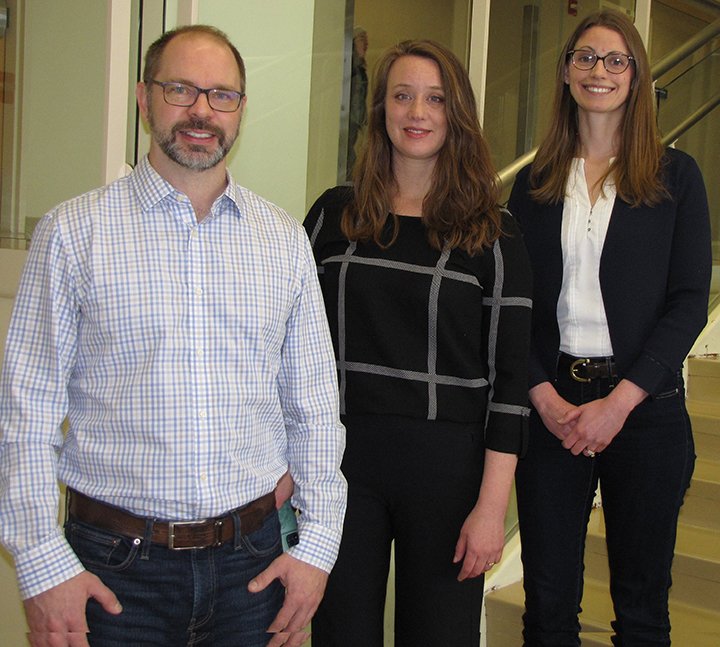SDSU researchers hope $10.8M grant helps unlock biomedical answers
Photo by University Marketing and Communications
South Dakota State University researchers Adam Hoppe, Natalie Thiex and Darci Fink will benefit from a nearly $11 million grant from the National Institutes of Health. The five-year federal grant will help researchers look into inflammation.
April 26, 2022
A $10.8 million grant has been given to South Dakota State University for its work in biomedical research and will fund work in continuing research for the next five years.
The National Institutes of Health will fund the biomedical research in the newly created Center of Biomedical Research Excellence, which is an extension of the South Dakota BioSystems Networks and Translational Research center built in 2013, according to a press release.
“What the center aims to do is really build strong biomedical research at SDSU,” said Adam Hoppe, the primary investigator and center director.
Hoppe cited Radhey Kaushik, head of the biology and microbiology department, for “playing an integral role in developing the proposal and contributing to the project by providing his immunology expertise and administrative support.”
The award will serve as an “accelerator” to advance the work of junior researchers to the level they can receive sustained funding from the National Institutes of Health and the National Science Foundation, Hoppe said.
The researchers whose work will be funded are Natalie Thiex and Darci Fink.
Thiex’s work is mainly with macrophages, which are the white blood cells that work during wound repairs.
Macrophages are the most important in inflammatory responses and regulating them as they help clean out the wound. There is a balance between the start of the healing process and the ending. When left unchecked, there is an increased risk for various diseases, Hoppe said.
The question that Thiex will try to solve is how cells communicate with each other in a wound site to begin working.
Thiex, who has done work in this area, has been awarded smaller grants from the National Institutes of Health in the past, but the latest grant will make it possible to answer the question.
Darci Fink studies the lymphatics and the formation of lymphatic vessels. The lymphatic system is a network of vessels and organs that regulates the amount of fluid in the human body and defends it against infection.
Around the site of inflammation, you can grow new lymphatic vessels. What remains a mystery is how these cells grow, organize themselves into functional structures and how they communicate with each other and the tissue they’re growing in, Hoppe said.
Fink, who has received smaller awards as well, will try and answer that question.
“To me, research is about channeling endless curiosity into a structured project with outcomes that might someday make a difference for someone else’s health,” Fink said.
A third project leader is on the to-do list, and it will be a lengthy process as it involves advisory committee recommendations and approval from the National Institutes of Health, according to a press release. Any junior faculty member at SDSU who has research relating to inflammation at cellular or molecular level would be eligible to apply.
Equipment and facility upgrades are also planned, according to a press release.
A $300,000 microscope will be housed in the McFadden Biostress Laboratory and will help with the imaging of cellular and molecular organisms during inflammation, Hoppe said.
Another purchase will be an addition to already existing equipment. The $100,000 item will help researchers determine gene expressions within individual cells, helping understand how they communicate during inflammation.
With those purchases comes an immediate $300,000 update to the small animal research facility within the university’s animal resource wing, according to a press release.
While the Center of Biomedical Research Excellence is focused on SDSU, it will expand partnerships with the School of Mines and the University of South Dakota, who were a part of the original South Dakota BioSystems Networks and Translational Research Center.
“Basic biomedical research has always been a part of what we have been doing at SDSU,” Hoppe said. “This is taking it to the next level.”
























